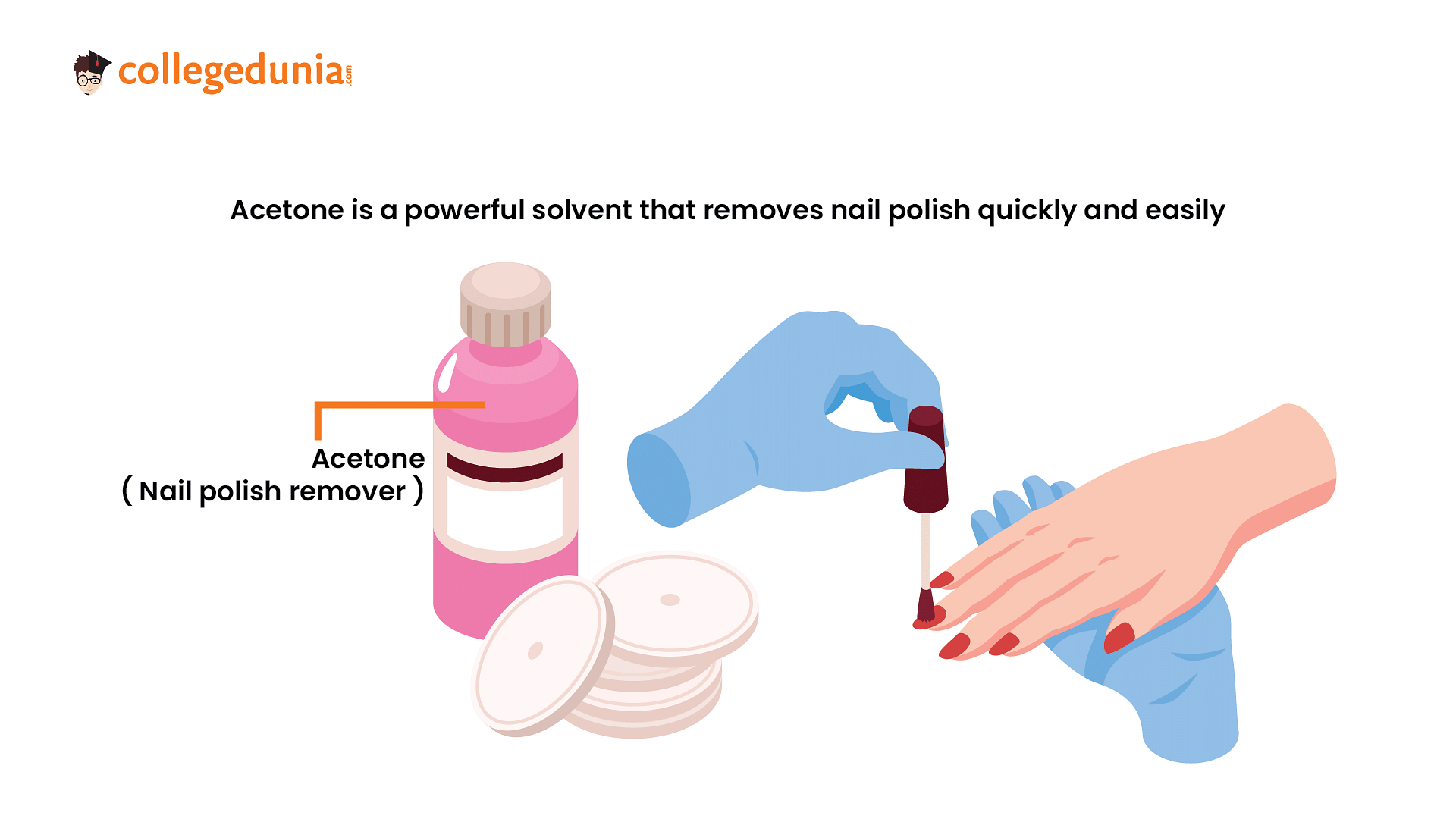Isopropyl alcohol on oxidation forms
Show Hint
Isopropyl alcohol, also known as rubbing alcohol, is a commonly used solvent and antiseptic.
- Acetone
- Ether
- Ethylene
- Acetaldehyde
The Correct Option is A
Approach Solution - 1
The correct answer is Option A) Acetone
Isopropyl alcohol on oxidation leads to the formation of acetone.
The reaction is as follows: \(CH _{3} CH ( OH ) CH _{3} -> CH _{3} COCH _{3}\) in the presence of [O] and {H+}.
Discover More From Chapter: Alcohols Phenols and Ethers
Approach Solution -2
The correct answer is Option A) Acetone
Real Life Applications
- Acetone is used in industrial cleaning processes and as a general-purpose solvent in household products.
- Nail polish removers due to its ability to effectively dissolve
- Significantly used to achieve the desired consistency of certain paints and coatings as paint thinner.
- Acetone is used in the extraction of natural products and essential oils from plants. Used as a disinfectant in medical sector.

Question can also be asked as
- What is the product of the oxidation of isopropyl alcohol?
- What is the role of acetone as a chemical intermediate?
- What is the chemical reaction for the oxidation of isopropyl alcohol?
- Can we use this a s fuel in IC engines?
Approach Solution -3
The correct answer is Option A) Acetone
Isopropyl alcohol, also known as rubbing alcohol, is a commonly used solvent and antiseptic. It can undergo oxidation reactions, leading to the formation of various products.
Isopropyl Alcohol (IPA)
- Isopropyl alcohol is a colorless, flammable liquid with the chemical formula C3H8O.
- It is commonly used as a solvent, disinfectant, and cleaning agent.
Oxidation Reaction
- Oxidation is a chemical process that involves the loss of electrons or an increase in the oxidation state.
- Isopropyl alcohol can undergo oxidation when exposed to certain oxidizing agents.
Formation of Acetone
- When isopropyl alcohol is oxidized, it forms acetone (propanone).
- Acetone is a colorless, volatile liquid with the chemical formula CH3COCH3.
The oxidation of isopropyl alcohol involves the removal of hydrogen atoms from the alcohol group (OH) and the formation of a carbonyl group (C=O) in acetone. This oxidation process involves the transfer of electrons from the alcohol to the oxidizing agent.
Check Out:
Top Questions on Aldehydes, Ketones and Carboxylic Acids
- An organic compound (X) having molecular formula C$_5$H$_10$O can show various properties depending on its structures. Draw each of the structures if it:
(I) shows Cannizzaro reaction.
(II) reduces Tollens' reagent and has a chiral carbon.
(III) gives positive iodoform test.- CBSE CLASS XII - 2025
- Chemistry
- Aldehydes, Ketones and Carboxylic Acids
In the given reaction sequence, the structure of Y would be:

- CBSE CLASS XII - 2025
- Chemistry
- Aldehydes, Ketones and Carboxylic Acids
- What do you understand by these following terms? Give one example of each.
(i) Aldol (ii) Schiff's base (iii) Cannizaro's reaction (iv) Oxime (v) Acetal- UP Board XII - 2025
- Chemistry
- Aldehydes, Ketones and Carboxylic Acids
- What are X, Y, Z respectively in the following reaction sequence?
CH$_3$CH=CHCH$_3$ $\xrightarrow{X}$ CH$_3$COOH $\xrightarrow{Y}$ CH$_3$CO-Cl $\xrightarrow{Z, C6H5NH2}$ C$_6$H$_5$NHCOCH$_3$- TS EAMCET - 2025
- Chemistry
- Aldehydes, Ketones and Carboxylic Acids
- Identify the sets containing correct order against the property mentioned from the following

- TS EAMCET - 2025
- Chemistry
- Aldehydes, Ketones and Carboxylic Acids
Concepts Used:
Aldehydes, Ketones, and Carboxylic Acids
Aldehydes, Ketones, and Carboxylic Acids are carbonyl compounds that contain a carbon-oxygen double bond. These organic compounds are very important in the field of organic chemistry and also have many industrial applications.
Aldehydes:
Aldehydes are organic compounds that have the functional group -CHO.
Preparation of Aldehydes
Acid chlorides are reduced to aldehydes with hydrogen in the presence of palladium catalyst spread on barium sulfate.
Ketones:
Ketones are organic compounds that have the functional group C=O and the structure R-(C=O)-R’.
Preparation of Ketones
Acid chlorides on reaction with dialkyl cadmium produce ketones. Dialkyl cadmium themselves are prepared from Grignard reagents.
Carboxylic Acid:
Carboxylic acids are organic compounds that contain a (C=O)OH group attached to an R group (where R refers to the remaining part of the molecule).
Preparation of Carboxylic Acids
Primary alcohols are readily oxidized to carboxylic acids with common oxidizing agents such as potassium permanganate in neutral acidic or alkaline media or by potassium dichromate and chromium trioxide in acidic media.